Principles of Marketing: Bupa BEAM Concept Marketing Report
VerifiedAdded on 2022/12/09
|19
|3951
|239
Report
AI Summary
This report presents a marketing analysis of Bupa's BEAM (Bupa Emergency and Acute Medical) concept, focusing on its introduction, environmental factors, and marketing mix. The report begins by introducing the marketing idea and outlining the marketing planning process, emphasizing the importance of marketing orientation. It then conducts a PESTEL analysis to assess the macro-environmental factors, including political, economic, social, technological, environmental, and legal aspects. The micro-environmental analysis examines competitors and other relevant organizational factors. The report further outlines the 7Ps of the extended marketing mix, explaining how each element contributes to effective marketing planning. The second section delves into market segmentation, targeting, and positioning, differentiating between B2B and B2C markets. It explores various segmentation approaches, including demographic, psychological, and behavioral factors, and discusses appropriate targeting methods for both market segments. The final section analyzes the marketing mix, integrating the concepts from the previous sections to develop comprehensive marketing strategies for Bupa's BEAM concept. The report also provides references to support the analysis.

Running head: MARKETING MANAGEMENT
Marketing Management
Name of the Student
Name of the University
Author Note
Marketing Management
Name of the Student
Name of the University
Author Note
Paraphrase This Document
Need a fresh take? Get an instant paraphrase of this document with our AI Paraphraser
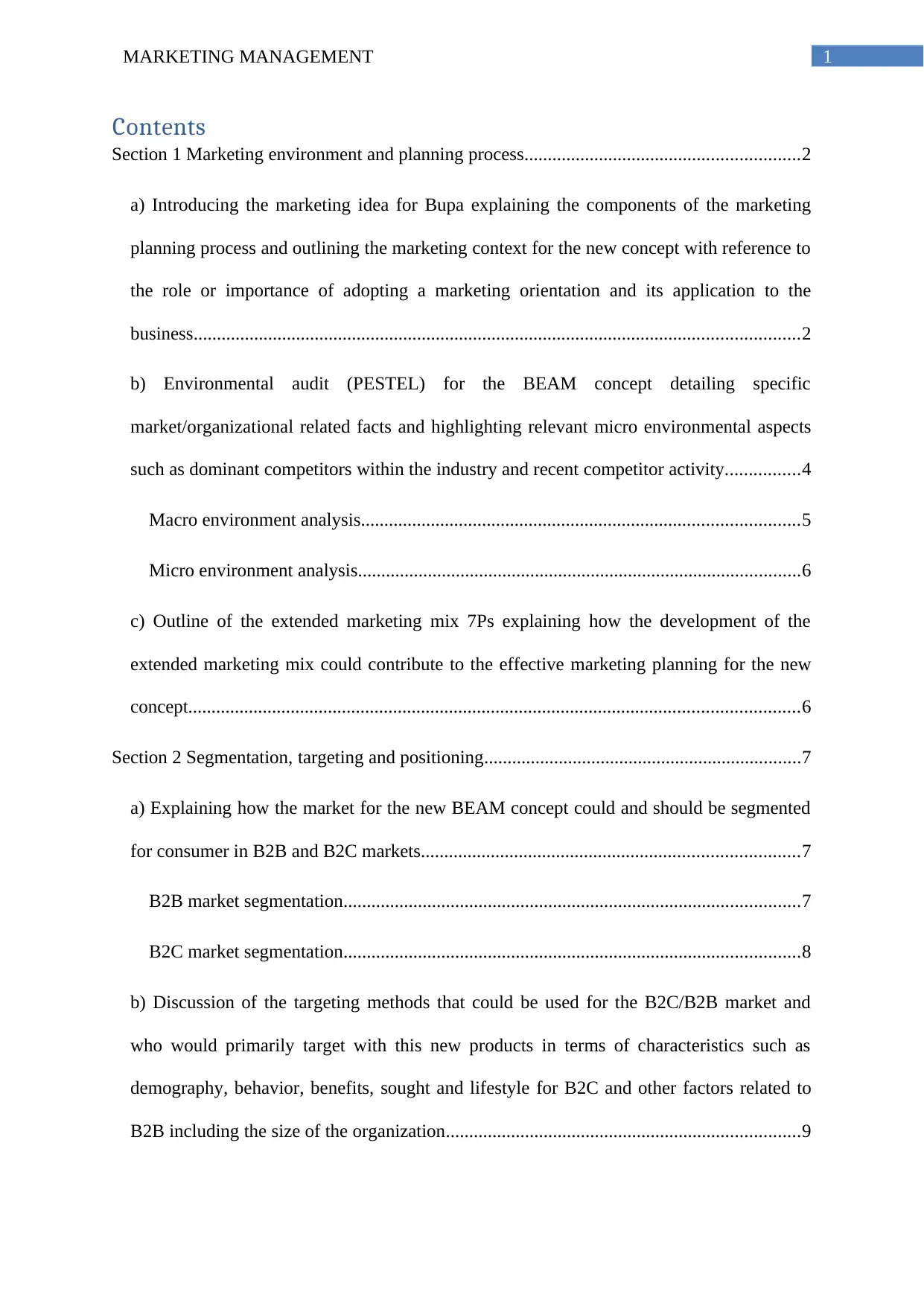
1MARKETING MANAGEMENT
Contents
Section 1 Marketing environment and planning process...........................................................2
a) Introducing the marketing idea for Bupa explaining the components of the marketing
planning process and outlining the marketing context for the new concept with reference to
the role or importance of adopting a marketing orientation and its application to the
business..................................................................................................................................2
b) Environmental audit (PESTEL) for the BEAM concept detailing specific
market/organizational related facts and highlighting relevant micro environmental aspects
such as dominant competitors within the industry and recent competitor activity................4
Macro environment analysis..............................................................................................5
Micro environment analysis...............................................................................................6
c) Outline of the extended marketing mix 7Ps explaining how the development of the
extended marketing mix could contribute to the effective marketing planning for the new
concept...................................................................................................................................6
Section 2 Segmentation, targeting and positioning....................................................................7
a) Explaining how the market for the new BEAM concept could and should be segmented
for consumer in B2B and B2C markets.................................................................................7
B2B market segmentation..................................................................................................7
B2C market segmentation..................................................................................................8
b) Discussion of the targeting methods that could be used for the B2C/B2B market and
who would primarily target with this new products in terms of characteristics such as
demography, behavior, benefits, sought and lifestyle for B2C and other factors related to
B2B including the size of the organization............................................................................9
Contents
Section 1 Marketing environment and planning process...........................................................2
a) Introducing the marketing idea for Bupa explaining the components of the marketing
planning process and outlining the marketing context for the new concept with reference to
the role or importance of adopting a marketing orientation and its application to the
business..................................................................................................................................2
b) Environmental audit (PESTEL) for the BEAM concept detailing specific
market/organizational related facts and highlighting relevant micro environmental aspects
such as dominant competitors within the industry and recent competitor activity................4
Macro environment analysis..............................................................................................5
Micro environment analysis...............................................................................................6
c) Outline of the extended marketing mix 7Ps explaining how the development of the
extended marketing mix could contribute to the effective marketing planning for the new
concept...................................................................................................................................6
Section 2 Segmentation, targeting and positioning....................................................................7
a) Explaining how the market for the new BEAM concept could and should be segmented
for consumer in B2B and B2C markets.................................................................................7
B2B market segmentation..................................................................................................7
B2C market segmentation..................................................................................................8
b) Discussion of the targeting methods that could be used for the B2C/B2B market and
who would primarily target with this new products in terms of characteristics such as
demography, behavior, benefits, sought and lifestyle for B2C and other factors related to
B2B including the size of the organization............................................................................9
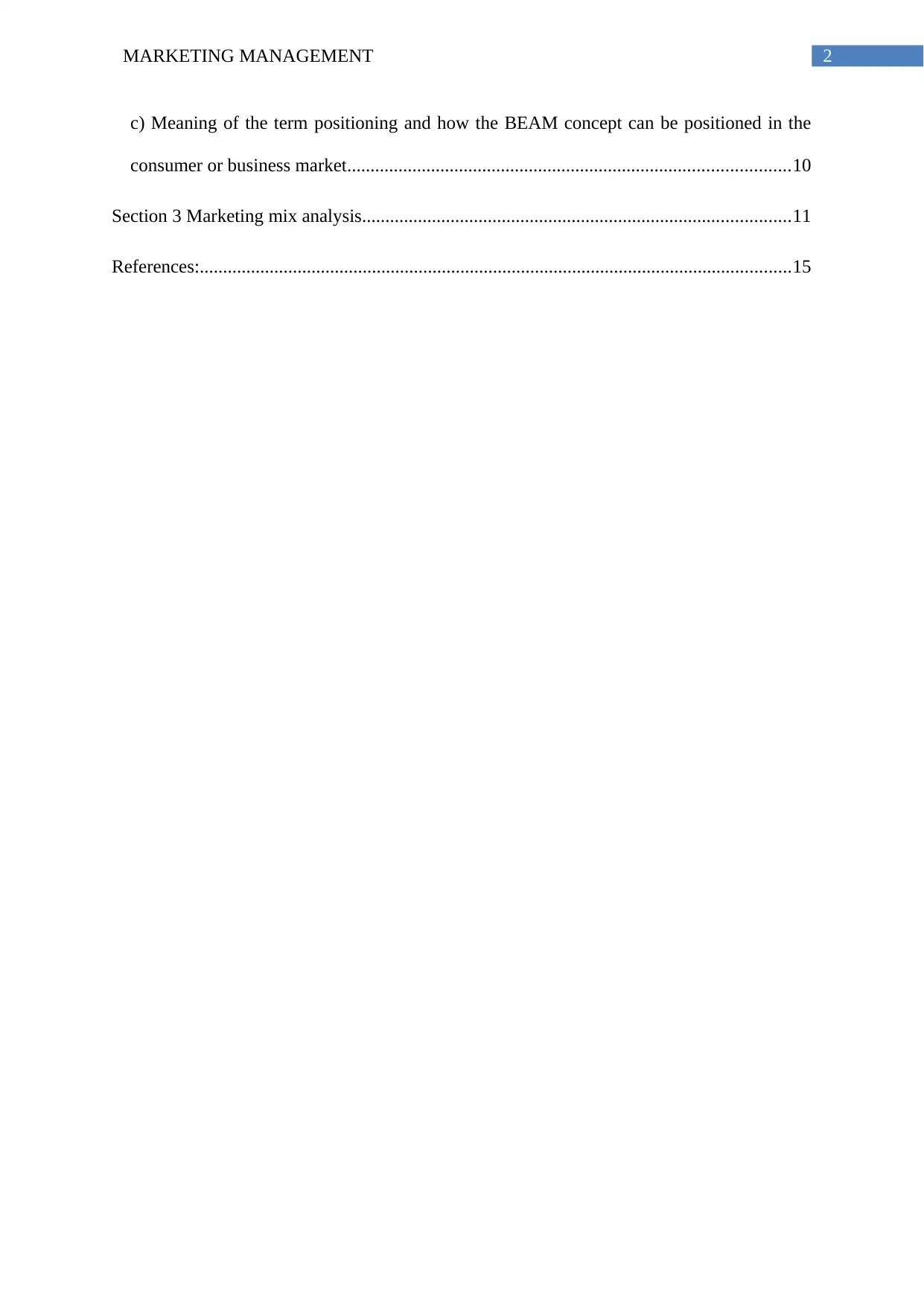
2MARKETING MANAGEMENT
c) Meaning of the term positioning and how the BEAM concept can be positioned in the
consumer or business market...............................................................................................10
Section 3 Marketing mix analysis............................................................................................11
References:...............................................................................................................................15
c) Meaning of the term positioning and how the BEAM concept can be positioned in the
consumer or business market...............................................................................................10
Section 3 Marketing mix analysis............................................................................................11
References:...............................................................................................................................15
⊘ This is a preview!⊘
Do you want full access?
Subscribe today to unlock all pages.

Trusted by 1+ million students worldwide
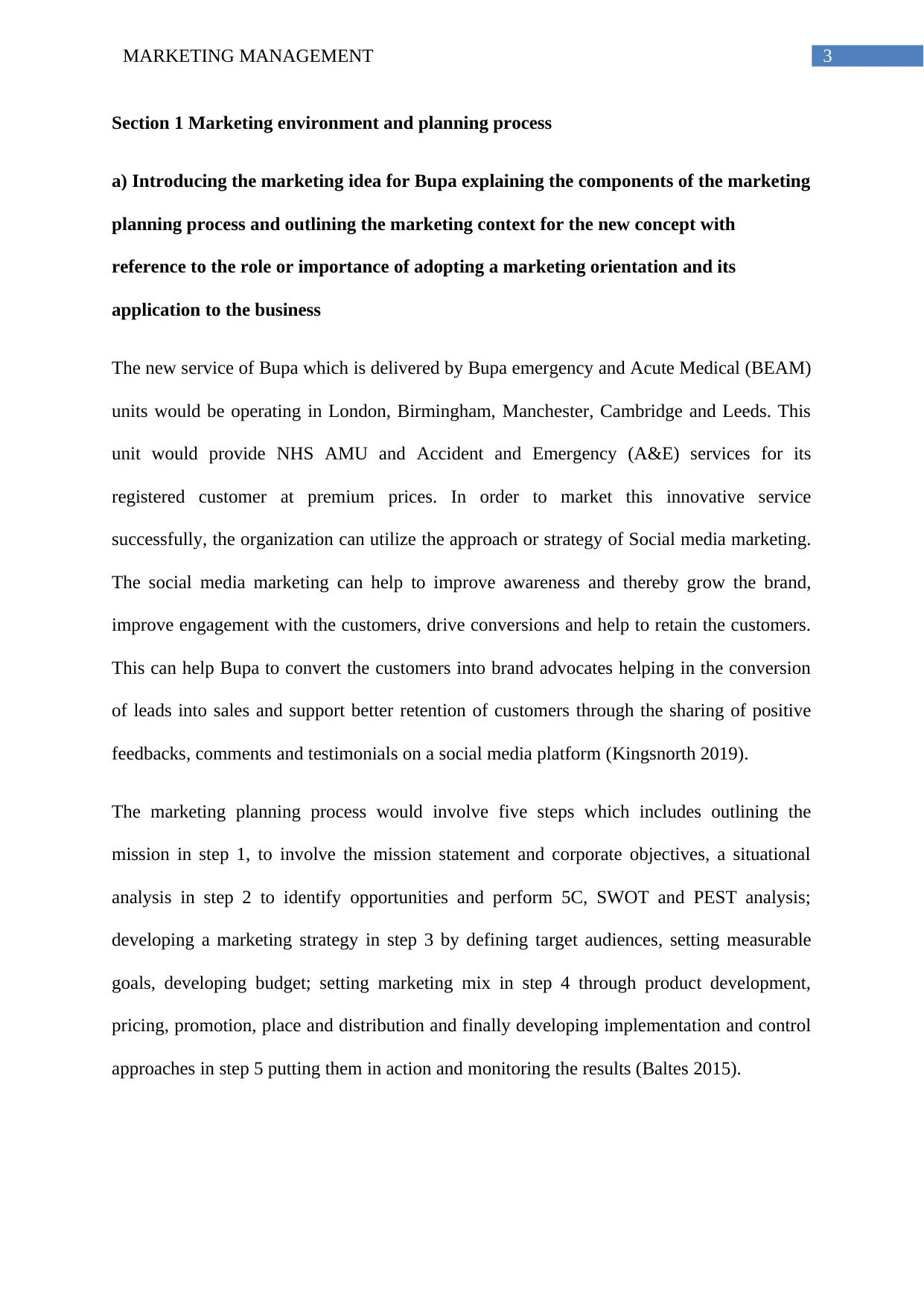
3MARKETING MANAGEMENT
Section 1 Marketing environment and planning process
a) Introducing the marketing idea for Bupa explaining the components of the marketing
planning process and outlining the marketing context for the new concept with
reference to the role or importance of adopting a marketing orientation and its
application to the business
The new service of Bupa which is delivered by Bupa emergency and Acute Medical (BEAM)
units would be operating in London, Birmingham, Manchester, Cambridge and Leeds. This
unit would provide NHS AMU and Accident and Emergency (A&E) services for its
registered customer at premium prices. In order to market this innovative service
successfully, the organization can utilize the approach or strategy of Social media marketing.
The social media marketing can help to improve awareness and thereby grow the brand,
improve engagement with the customers, drive conversions and help to retain the customers.
This can help Bupa to convert the customers into brand advocates helping in the conversion
of leads into sales and support better retention of customers through the sharing of positive
feedbacks, comments and testimonials on a social media platform (Kingsnorth 2019).
The marketing planning process would involve five steps which includes outlining the
mission in step 1, to involve the mission statement and corporate objectives, a situational
analysis in step 2 to identify opportunities and perform 5C, SWOT and PEST analysis;
developing a marketing strategy in step 3 by defining target audiences, setting measurable
goals, developing budget; setting marketing mix in step 4 through product development,
pricing, promotion, place and distribution and finally developing implementation and control
approaches in step 5 putting them in action and monitoring the results (Baltes 2015).
Section 1 Marketing environment and planning process
a) Introducing the marketing idea for Bupa explaining the components of the marketing
planning process and outlining the marketing context for the new concept with
reference to the role or importance of adopting a marketing orientation and its
application to the business
The new service of Bupa which is delivered by Bupa emergency and Acute Medical (BEAM)
units would be operating in London, Birmingham, Manchester, Cambridge and Leeds. This
unit would provide NHS AMU and Accident and Emergency (A&E) services for its
registered customer at premium prices. In order to market this innovative service
successfully, the organization can utilize the approach or strategy of Social media marketing.
The social media marketing can help to improve awareness and thereby grow the brand,
improve engagement with the customers, drive conversions and help to retain the customers.
This can help Bupa to convert the customers into brand advocates helping in the conversion
of leads into sales and support better retention of customers through the sharing of positive
feedbacks, comments and testimonials on a social media platform (Kingsnorth 2019).
The marketing planning process would involve five steps which includes outlining the
mission in step 1, to involve the mission statement and corporate objectives, a situational
analysis in step 2 to identify opportunities and perform 5C, SWOT and PEST analysis;
developing a marketing strategy in step 3 by defining target audiences, setting measurable
goals, developing budget; setting marketing mix in step 4 through product development,
pricing, promotion, place and distribution and finally developing implementation and control
approaches in step 5 putting them in action and monitoring the results (Baltes 2015).
Paraphrase This Document
Need a fresh take? Get an instant paraphrase of this document with our AI Paraphraser
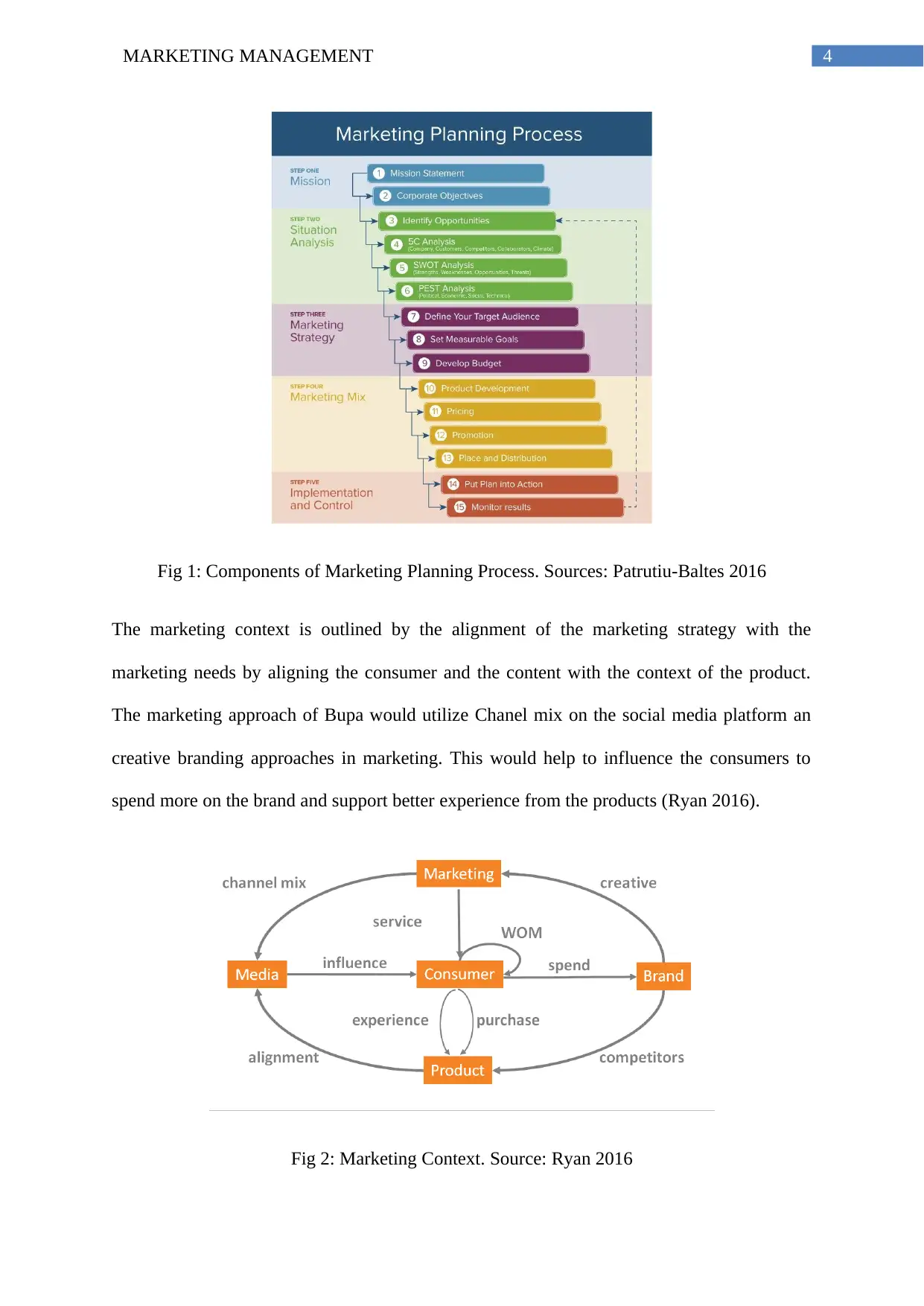
4MARKETING MANAGEMENT
Fig 1: Components of Marketing Planning Process. Sources: Patrutiu-Baltes 2016
The marketing context is outlined by the alignment of the marketing strategy with the
marketing needs by aligning the consumer and the content with the context of the product.
The marketing approach of Bupa would utilize Chanel mix on the social media platform an
creative branding approaches in marketing. This would help to influence the consumers to
spend more on the brand and support better experience from the products (Ryan 2016).
Fig 2: Marketing Context. Source: Ryan 2016
Fig 1: Components of Marketing Planning Process. Sources: Patrutiu-Baltes 2016
The marketing context is outlined by the alignment of the marketing strategy with the
marketing needs by aligning the consumer and the content with the context of the product.
The marketing approach of Bupa would utilize Chanel mix on the social media platform an
creative branding approaches in marketing. This would help to influence the consumers to
spend more on the brand and support better experience from the products (Ryan 2016).
Fig 2: Marketing Context. Source: Ryan 2016
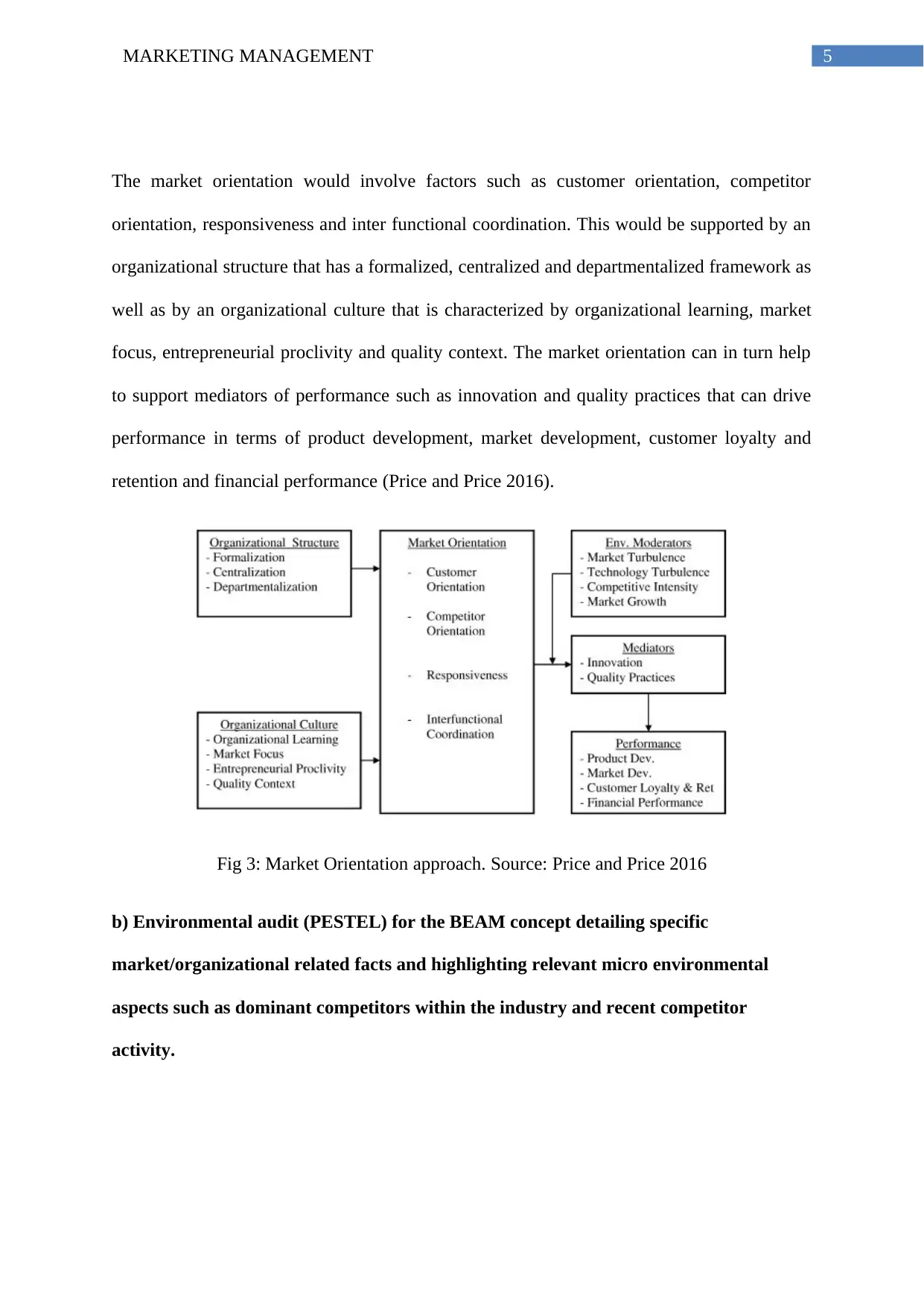
5MARKETING MANAGEMENT
The market orientation would involve factors such as customer orientation, competitor
orientation, responsiveness and inter functional coordination. This would be supported by an
organizational structure that has a formalized, centralized and departmentalized framework as
well as by an organizational culture that is characterized by organizational learning, market
focus, entrepreneurial proclivity and quality context. The market orientation can in turn help
to support mediators of performance such as innovation and quality practices that can drive
performance in terms of product development, market development, customer loyalty and
retention and financial performance (Price and Price 2016).
Fig 3: Market Orientation approach. Source: Price and Price 2016
b) Environmental audit (PESTEL) for the BEAM concept detailing specific
market/organizational related facts and highlighting relevant micro environmental
aspects such as dominant competitors within the industry and recent competitor
activity.
The market orientation would involve factors such as customer orientation, competitor
orientation, responsiveness and inter functional coordination. This would be supported by an
organizational structure that has a formalized, centralized and departmentalized framework as
well as by an organizational culture that is characterized by organizational learning, market
focus, entrepreneurial proclivity and quality context. The market orientation can in turn help
to support mediators of performance such as innovation and quality practices that can drive
performance in terms of product development, market development, customer loyalty and
retention and financial performance (Price and Price 2016).
Fig 3: Market Orientation approach. Source: Price and Price 2016
b) Environmental audit (PESTEL) for the BEAM concept detailing specific
market/organizational related facts and highlighting relevant micro environmental
aspects such as dominant competitors within the industry and recent competitor
activity.
⊘ This is a preview!⊘
Do you want full access?
Subscribe today to unlock all pages.

Trusted by 1+ million students worldwide
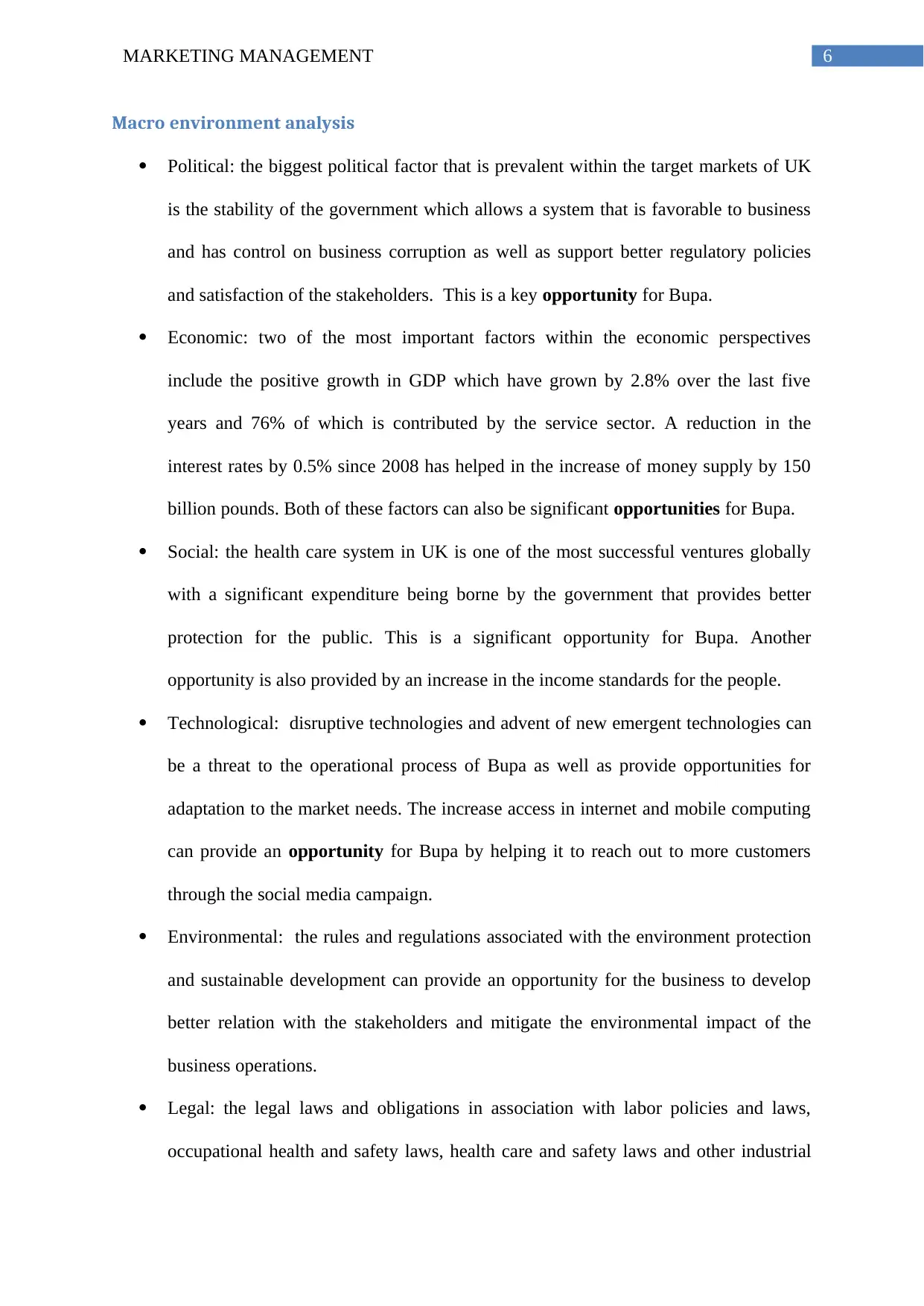
6MARKETING MANAGEMENT
Macro environment analysis
Political: the biggest political factor that is prevalent within the target markets of UK
is the stability of the government which allows a system that is favorable to business
and has control on business corruption as well as support better regulatory policies
and satisfaction of the stakeholders. This is a key opportunity for Bupa.
Economic: two of the most important factors within the economic perspectives
include the positive growth in GDP which have grown by 2.8% over the last five
years and 76% of which is contributed by the service sector. A reduction in the
interest rates by 0.5% since 2008 has helped in the increase of money supply by 150
billion pounds. Both of these factors can also be significant opportunities for Bupa.
Social: the health care system in UK is one of the most successful ventures globally
with a significant expenditure being borne by the government that provides better
protection for the public. This is a significant opportunity for Bupa. Another
opportunity is also provided by an increase in the income standards for the people.
Technological: disruptive technologies and advent of new emergent technologies can
be a threat to the operational process of Bupa as well as provide opportunities for
adaptation to the market needs. The increase access in internet and mobile computing
can provide an opportunity for Bupa by helping it to reach out to more customers
through the social media campaign.
Environmental: the rules and regulations associated with the environment protection
and sustainable development can provide an opportunity for the business to develop
better relation with the stakeholders and mitigate the environmental impact of the
business operations.
Legal: the legal laws and obligations in association with labor policies and laws,
occupational health and safety laws, health care and safety laws and other industrial
Macro environment analysis
Political: the biggest political factor that is prevalent within the target markets of UK
is the stability of the government which allows a system that is favorable to business
and has control on business corruption as well as support better regulatory policies
and satisfaction of the stakeholders. This is a key opportunity for Bupa.
Economic: two of the most important factors within the economic perspectives
include the positive growth in GDP which have grown by 2.8% over the last five
years and 76% of which is contributed by the service sector. A reduction in the
interest rates by 0.5% since 2008 has helped in the increase of money supply by 150
billion pounds. Both of these factors can also be significant opportunities for Bupa.
Social: the health care system in UK is one of the most successful ventures globally
with a significant expenditure being borne by the government that provides better
protection for the public. This is a significant opportunity for Bupa. Another
opportunity is also provided by an increase in the income standards for the people.
Technological: disruptive technologies and advent of new emergent technologies can
be a threat to the operational process of Bupa as well as provide opportunities for
adaptation to the market needs. The increase access in internet and mobile computing
can provide an opportunity for Bupa by helping it to reach out to more customers
through the social media campaign.
Environmental: the rules and regulations associated with the environment protection
and sustainable development can provide an opportunity for the business to develop
better relation with the stakeholders and mitigate the environmental impact of the
business operations.
Legal: the legal laws and obligations in association with labor policies and laws,
occupational health and safety laws, health care and safety laws and other industrial
Paraphrase This Document
Need a fresh take? Get an instant paraphrase of this document with our AI Paraphraser
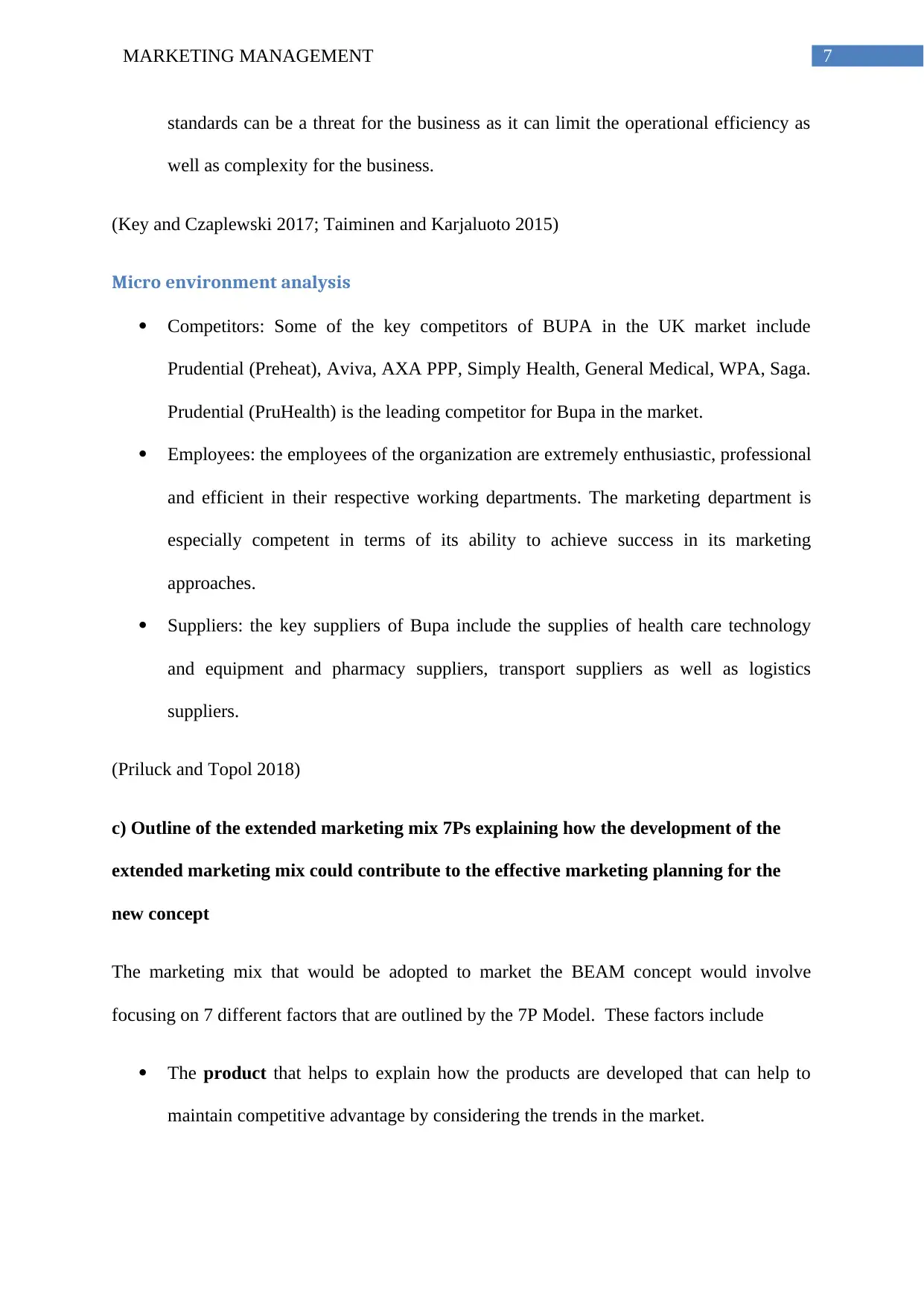
7MARKETING MANAGEMENT
standards can be a threat for the business as it can limit the operational efficiency as
well as complexity for the business.
(Key and Czaplewski 2017; Taiminen and Karjaluoto 2015)
Micro environment analysis
Competitors: Some of the key competitors of BUPA in the UK market include
Prudential (Preheat), Aviva, AXA PPP, Simply Health, General Medical, WPA, Saga.
Prudential (PruHealth) is the leading competitor for Bupa in the market.
Employees: the employees of the organization are extremely enthusiastic, professional
and efficient in their respective working departments. The marketing department is
especially competent in terms of its ability to achieve success in its marketing
approaches.
Suppliers: the key suppliers of Bupa include the supplies of health care technology
and equipment and pharmacy suppliers, transport suppliers as well as logistics
suppliers.
(Priluck and Topol 2018)
c) Outline of the extended marketing mix 7Ps explaining how the development of the
extended marketing mix could contribute to the effective marketing planning for the
new concept
The marketing mix that would be adopted to market the BEAM concept would involve
focusing on 7 different factors that are outlined by the 7P Model. These factors include
The product that helps to explain how the products are developed that can help to
maintain competitive advantage by considering the trends in the market.
standards can be a threat for the business as it can limit the operational efficiency as
well as complexity for the business.
(Key and Czaplewski 2017; Taiminen and Karjaluoto 2015)
Micro environment analysis
Competitors: Some of the key competitors of BUPA in the UK market include
Prudential (Preheat), Aviva, AXA PPP, Simply Health, General Medical, WPA, Saga.
Prudential (PruHealth) is the leading competitor for Bupa in the market.
Employees: the employees of the organization are extremely enthusiastic, professional
and efficient in their respective working departments. The marketing department is
especially competent in terms of its ability to achieve success in its marketing
approaches.
Suppliers: the key suppliers of Bupa include the supplies of health care technology
and equipment and pharmacy suppliers, transport suppliers as well as logistics
suppliers.
(Priluck and Topol 2018)
c) Outline of the extended marketing mix 7Ps explaining how the development of the
extended marketing mix could contribute to the effective marketing planning for the
new concept
The marketing mix that would be adopted to market the BEAM concept would involve
focusing on 7 different factors that are outlined by the 7P Model. These factors include
The product that helps to explain how the products are developed that can help to
maintain competitive advantage by considering the trends in the market.

8MARKETING MANAGEMENT
The place that explains the arrangement of distribution that can maximize the number
of customers and business profitability and also understand the catchment area of
customers for a business.
The price this helps to explains and outline how the pricing would be set for the
products for services that reflects both the objectives of the organization and the
condition of the market.
The promotion which helps to illustrate how promotional activities can be integrated
to achieve the objectives of marketing and the communications mix by involving the
social media and also analyze elements pertinent to the marketing mix.
The people, which helps to understand the importance of employees to a brand and
the significance of the brad image and therefore helps to focus on the humanistic
significance of the brand image.
Physical evidence which help to understand the significance of the visible elements
of the brand in terms of how it supports the positioning and the consistency of the
brand.
Process, helps to understand the significance of the convenience of customers in
terms of accessing or availing the services offered by the business.
(Ismail et al. 2017; Hamill 2016)
Section 2 Segmentation, targeting and positioning
a) Explaining how the market for the new BEAM concept could and should be
segmented for consumer in B2B and B2C markets
B2B market segmentation
The B2B market segmentation approaches that could and should be used by Bupa for
marketing for BEAM can include the following approaches:
The place that explains the arrangement of distribution that can maximize the number
of customers and business profitability and also understand the catchment area of
customers for a business.
The price this helps to explains and outline how the pricing would be set for the
products for services that reflects both the objectives of the organization and the
condition of the market.
The promotion which helps to illustrate how promotional activities can be integrated
to achieve the objectives of marketing and the communications mix by involving the
social media and also analyze elements pertinent to the marketing mix.
The people, which helps to understand the importance of employees to a brand and
the significance of the brad image and therefore helps to focus on the humanistic
significance of the brand image.
Physical evidence which help to understand the significance of the visible elements
of the brand in terms of how it supports the positioning and the consistency of the
brand.
Process, helps to understand the significance of the convenience of customers in
terms of accessing or availing the services offered by the business.
(Ismail et al. 2017; Hamill 2016)
Section 2 Segmentation, targeting and positioning
a) Explaining how the market for the new BEAM concept could and should be
segmented for consumer in B2B and B2C markets
B2B market segmentation
The B2B market segmentation approaches that could and should be used by Bupa for
marketing for BEAM can include the following approaches:
⊘ This is a preview!⊘
Do you want full access?
Subscribe today to unlock all pages.

Trusted by 1+ million students worldwide
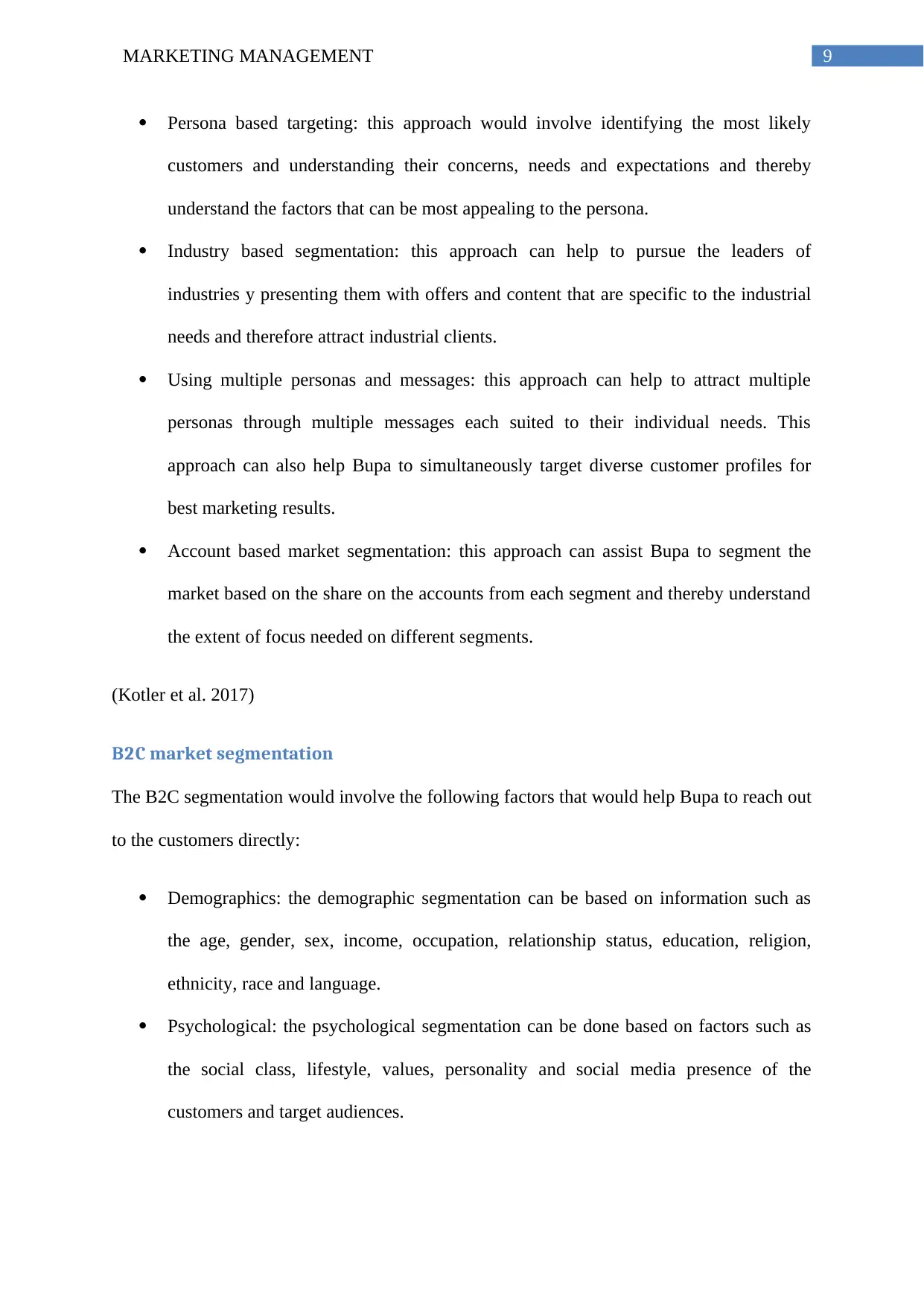
9MARKETING MANAGEMENT
Persona based targeting: this approach would involve identifying the most likely
customers and understanding their concerns, needs and expectations and thereby
understand the factors that can be most appealing to the persona.
Industry based segmentation: this approach can help to pursue the leaders of
industries y presenting them with offers and content that are specific to the industrial
needs and therefore attract industrial clients.
Using multiple personas and messages: this approach can help to attract multiple
personas through multiple messages each suited to their individual needs. This
approach can also help Bupa to simultaneously target diverse customer profiles for
best marketing results.
Account based market segmentation: this approach can assist Bupa to segment the
market based on the share on the accounts from each segment and thereby understand
the extent of focus needed on different segments.
(Kotler et al. 2017)
B2C market segmentation
The B2C segmentation would involve the following factors that would help Bupa to reach out
to the customers directly:
Demographics: the demographic segmentation can be based on information such as
the age, gender, sex, income, occupation, relationship status, education, religion,
ethnicity, race and language.
Psychological: the psychological segmentation can be done based on factors such as
the social class, lifestyle, values, personality and social media presence of the
customers and target audiences.
Persona based targeting: this approach would involve identifying the most likely
customers and understanding their concerns, needs and expectations and thereby
understand the factors that can be most appealing to the persona.
Industry based segmentation: this approach can help to pursue the leaders of
industries y presenting them with offers and content that are specific to the industrial
needs and therefore attract industrial clients.
Using multiple personas and messages: this approach can help to attract multiple
personas through multiple messages each suited to their individual needs. This
approach can also help Bupa to simultaneously target diverse customer profiles for
best marketing results.
Account based market segmentation: this approach can assist Bupa to segment the
market based on the share on the accounts from each segment and thereby understand
the extent of focus needed on different segments.
(Kotler et al. 2017)
B2C market segmentation
The B2C segmentation would involve the following factors that would help Bupa to reach out
to the customers directly:
Demographics: the demographic segmentation can be based on information such as
the age, gender, sex, income, occupation, relationship status, education, religion,
ethnicity, race and language.
Psychological: the psychological segmentation can be done based on factors such as
the social class, lifestyle, values, personality and social media presence of the
customers and target audiences.
Paraphrase This Document
Need a fresh take? Get an instant paraphrase of this document with our AI Paraphraser
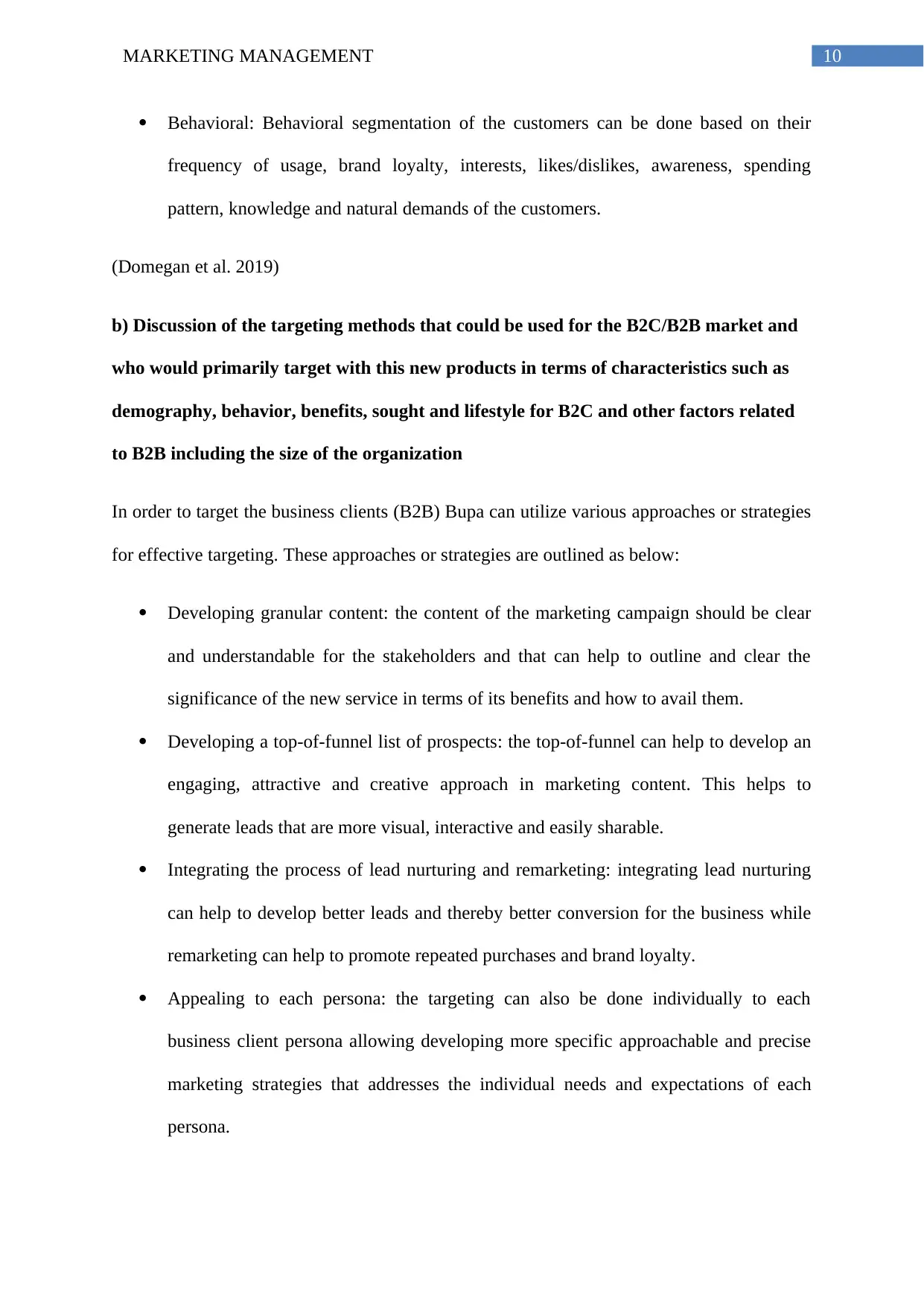
10MARKETING MANAGEMENT
Behavioral: Behavioral segmentation of the customers can be done based on their
frequency of usage, brand loyalty, interests, likes/dislikes, awareness, spending
pattern, knowledge and natural demands of the customers.
(Domegan et al. 2019)
b) Discussion of the targeting methods that could be used for the B2C/B2B market and
who would primarily target with this new products in terms of characteristics such as
demography, behavior, benefits, sought and lifestyle for B2C and other factors related
to B2B including the size of the organization
In order to target the business clients (B2B) Bupa can utilize various approaches or strategies
for effective targeting. These approaches or strategies are outlined as below:
Developing granular content: the content of the marketing campaign should be clear
and understandable for the stakeholders and that can help to outline and clear the
significance of the new service in terms of its benefits and how to avail them.
Developing a top-of-funnel list of prospects: the top-of-funnel can help to develop an
engaging, attractive and creative approach in marketing content. This helps to
generate leads that are more visual, interactive and easily sharable.
Integrating the process of lead nurturing and remarketing: integrating lead nurturing
can help to develop better leads and thereby better conversion for the business while
remarketing can help to promote repeated purchases and brand loyalty.
Appealing to each persona: the targeting can also be done individually to each
business client persona allowing developing more specific approachable and precise
marketing strategies that addresses the individual needs and expectations of each
persona.
Behavioral: Behavioral segmentation of the customers can be done based on their
frequency of usage, brand loyalty, interests, likes/dislikes, awareness, spending
pattern, knowledge and natural demands of the customers.
(Domegan et al. 2019)
b) Discussion of the targeting methods that could be used for the B2C/B2B market and
who would primarily target with this new products in terms of characteristics such as
demography, behavior, benefits, sought and lifestyle for B2C and other factors related
to B2B including the size of the organization
In order to target the business clients (B2B) Bupa can utilize various approaches or strategies
for effective targeting. These approaches or strategies are outlined as below:
Developing granular content: the content of the marketing campaign should be clear
and understandable for the stakeholders and that can help to outline and clear the
significance of the new service in terms of its benefits and how to avail them.
Developing a top-of-funnel list of prospects: the top-of-funnel can help to develop an
engaging, attractive and creative approach in marketing content. This helps to
generate leads that are more visual, interactive and easily sharable.
Integrating the process of lead nurturing and remarketing: integrating lead nurturing
can help to develop better leads and thereby better conversion for the business while
remarketing can help to promote repeated purchases and brand loyalty.
Appealing to each persona: the targeting can also be done individually to each
business client persona allowing developing more specific approachable and precise
marketing strategies that addresses the individual needs and expectations of each
persona.
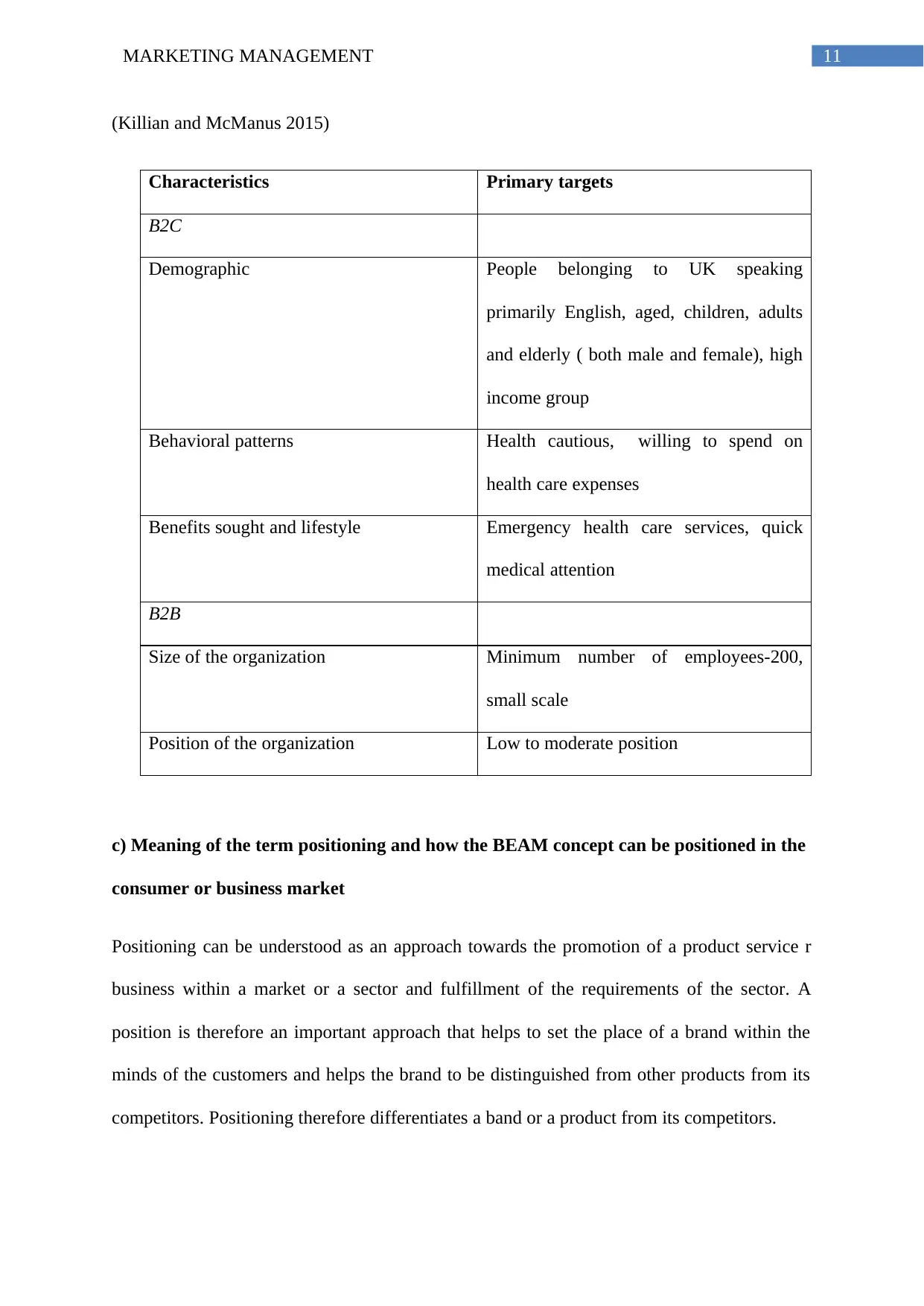
11MARKETING MANAGEMENT
(Killian and McManus 2015)
Characteristics Primary targets
B2C
Demographic People belonging to UK speaking
primarily English, aged, children, adults
and elderly ( both male and female), high
income group
Behavioral patterns Health cautious, willing to spend on
health care expenses
Benefits sought and lifestyle Emergency health care services, quick
medical attention
B2B
Size of the organization Minimum number of employees-200,
small scale
Position of the organization Low to moderate position
c) Meaning of the term positioning and how the BEAM concept can be positioned in the
consumer or business market
Positioning can be understood as an approach towards the promotion of a product service r
business within a market or a sector and fulfillment of the requirements of the sector. A
position is therefore an important approach that helps to set the place of a brand within the
minds of the customers and helps the brand to be distinguished from other products from its
competitors. Positioning therefore differentiates a band or a product from its competitors.
(Killian and McManus 2015)
Characteristics Primary targets
B2C
Demographic People belonging to UK speaking
primarily English, aged, children, adults
and elderly ( both male and female), high
income group
Behavioral patterns Health cautious, willing to spend on
health care expenses
Benefits sought and lifestyle Emergency health care services, quick
medical attention
B2B
Size of the organization Minimum number of employees-200,
small scale
Position of the organization Low to moderate position
c) Meaning of the term positioning and how the BEAM concept can be positioned in the
consumer or business market
Positioning can be understood as an approach towards the promotion of a product service r
business within a market or a sector and fulfillment of the requirements of the sector. A
position is therefore an important approach that helps to set the place of a brand within the
minds of the customers and helps the brand to be distinguished from other products from its
competitors. Positioning therefore differentiates a band or a product from its competitors.
⊘ This is a preview!⊘
Do you want full access?
Subscribe today to unlock all pages.

Trusted by 1+ million students worldwide
1 out of 19
Related Documents
Your All-in-One AI-Powered Toolkit for Academic Success.
+13062052269
info@desklib.com
Available 24*7 on WhatsApp / Email
![[object Object]](/_next/static/media/star-bottom.7253800d.svg)
Unlock your academic potential
Copyright © 2020–2025 A2Z Services. All Rights Reserved. Developed and managed by ZUCOL.



